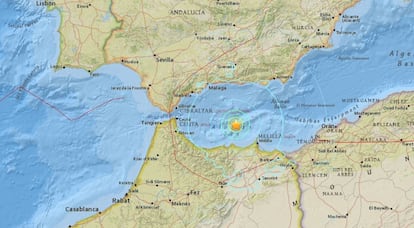Earthquake measuring 6.3 rocks Andalusia and Melilla
At least 26 injured in the Spanish exclave by the tremors, which also caused damage
An earthquake measuring 6.3 on the Richter scale was registered on Monday morning off the southeast coast of the Spanish city of Málaga, in the Alborán Sea. The tremors were felt across Andalusia, in cities such as Málaga, Granada, Seville and Jaén, as well as in the Spanish North African exclave of Melilla.
At least 26 people were injured in the Spanish territory, according to the central government’s representative there. The North African city was the worst affected by the quake, which cut off communications and electricity supplies from the moment it struck.
The fire service in Melilla is reported to be overwhelmed by the number of emergency calls from local residents
In the Moroccan city of Alhucemas a 12-year-old boy reportedly died of a heart attack in the early hours of the morning. The authorities are investigating whether it was related to the earth tremors. Civil Protection sources cited by news agency EFE say that the heart failure was due to him panicking when the earthquake hit.
The head of Melilla’s local government, Juan José Imbroda, also reported on Monday morning that cracks had been detected in a number of buildings. Schools in the city were closed for the day to allow authorities to inspect damage.

Emergency services in Melilla requested that local residents avoid using their vehicles in order to facilitate rescue work.
The Melilla fire service was reported to be overwhelmed by the number of emergency calls from local residents, news agency EFE said. Many local people came out of their houses and were on the streets because of fears of aftershocks.
The quake was also felt particularly strongly in Málaga. “It was awful – the building was moving as if it were made from cigarette paper,” said Ricardo Álvarez, who lives in a seventh-floor apartment in the El Palo fishing district.
However, neither fire services nor the local police in the Andalusian city have received reports of material damage to building façades or falling rubble.
The National Geographic Institute reports that the earthquake was registered at 5.22am, with its epicenter in the Alborán sea, between Alhucemas and Melilla. The institute detected a total of seven aftershocks, the strongest at 5.34am, measuring 4.5 on the Richter scale, and another measuring 4.4 at 7.10am.
Monday’s quake is the second registered in the area in recent days. On Friday there was a 4.9 tremor with its epicenter in the same area, followed by an aftershock measuring 3.0.
English version by Simon Hunter.
Tu suscripción se está usando en otro dispositivo
¿Quieres añadir otro usuario a tu suscripción?
Si continúas leyendo en este dispositivo, no se podrá leer en el otro.
FlechaTu suscripción se está usando en otro dispositivo y solo puedes acceder a EL PAÍS desde un dispositivo a la vez.
Si quieres compartir tu cuenta, cambia tu suscripción a la modalidad Premium, así podrás añadir otro usuario. Cada uno accederá con su propia cuenta de email, lo que os permitirá personalizar vuestra experiencia en EL PAÍS.
¿Tienes una suscripción de empresa? Accede aquí para contratar más cuentas.
En el caso de no saber quién está usando tu cuenta, te recomendamos cambiar tu contraseña aquí.
Si decides continuar compartiendo tu cuenta, este mensaje se mostrará en tu dispositivo y en el de la otra persona que está usando tu cuenta de forma indefinida, afectando a tu experiencia de lectura. Puedes consultar aquí los términos y condiciones de la suscripción digital.
Últimas noticias
Most viewed
- Alain Aspect, Nobel laureate in physics: ‘Einstein was so smart that he would have had to recognize quantum entanglement’
- Mexico’s missing people crisis casts a shadow over World Cup venue
- Why oil has been at the center of Venezuela-US conflicts for decades
- Trump clarifies who is ultimately in charge in Venezuela: ‘Me’
- Mexico seeks to shore up its defenses following US incursion in Venezuela









































